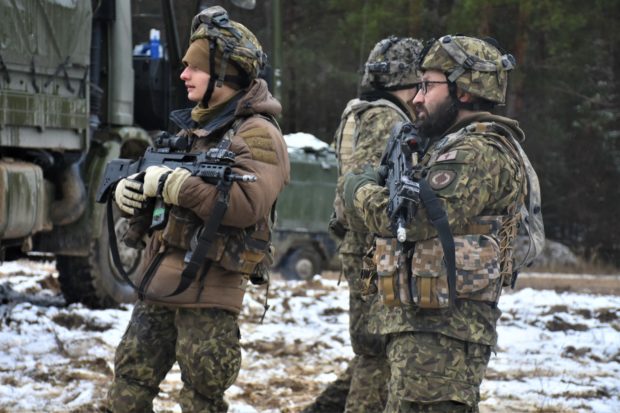US deploys 3,000 troops in Ukraine standoff

In this image released by he US Department of Defense, two NATO supply soldiers prepare to move to the location of their next mission during Allied Spirit 22 military exercise on January 31, 2022, at Joint Multinational Readiness Center, Hohenfels Training Area, Germany. – The US plans to deploy troops to fortify NATO forces in eastern Europe amid fears that Russia could invade Ukraine, a senior official of President Joe Biden’s administration said on February 2, 2022. According to US media reports, around 2,000 troops will be sent from Fort Bragg, North Carolina, to Poland and Germany, while another 1,000 already in Germany will be moved to Romania. (Photo by Alun Thomas / US DEPARTMENT OF STATE / AFP)
WASHINGTON — The United States on Wednesday deployed several thousand troops to bolster Nato forces in eastern Europe, as the leaders of France and Germany flagged trips to Moscow to address Western fears of an invasion of Ukraine.
With Russia refusing to pull back 100,000 troops poised on Ukraine’s borders, 1,000 US soldiers in Germany are being sent to Romania, and another 2,000 stationed in the United States are being flown to Germany and Poland.
“As long as (President Vladimir Putin) is acting aggressively, we are going to make sure we reassure our Nato allies in eastern Europe that we’re there,” President Joe Biden said after the deployments were announced.
In response, Russian Deputy Foreign Minister Alexander Grushko said the move would make it harder for a compromise between the two sides, calling the US deployments “destructive steps, which increase military tension and reduce scope for political decision.”
Western powers have been engaged in intense diplomatic efforts — coupled with the threat of sanctions against Putin’s inner circle — to deter what they fear to be a looming invasion of ex-Soviet Ukraine, despite strenuous denials from Moscow.
Article continues after this advertisementGermany’s Chancellor Olaf Scholz announced Wednesday he would soon travel to Moscow to discuss the crisis, while France’s President Emmanuel Macron said a similar trip may be in the cards — depending on upcoming talks with other world leaders.
Article continues after this advertisementBiden and Macron pledged to coordinate their response to the crisis in a phone call on Wednesday, while the French leader’s office said he would be talking to Putin again on Thursday evening.
No US troops in Ukraine
In Washington, Pentagon spokesman John Kirby stressed that the US troop movements were to demonstrate commitment to the NATO alliance, and that no American soldiers would be sent to fight in Ukraine, which is not a Nato member.
But that is unlikely to assuage Putin, who has accused the United States and Nato of seeking to “contain” Russia by placing troops and strategic arms on its border.
“Ukraine itself is just a tool to achieve this goal,” Putin said Tuesday in his first major comments in weeks on the crisis.
Putin has demanded guarantees that Ukraine will not join Nato, and has implicitly threatened the former Soviet state with the massive military buildup.
Russia also wants Nato and the United States to foreswear the deployment of missile systems near Russia’s borders and to pull back Nato forces in eastern Europe.
Putin has left the door open to talks, saying he was studying Western proposals set out last month in response to Russia’s demands, and that he hoped that “in the end we will find a solution.”
But in a phone call with British Prime Minister Boris Johnson on Wednesday, he noted “the unwillingness of Nato to adequately respond to the well-founded Russian concerns,” the Kremlin said.
The Kremlin also claimed it had China’s support in the standoff — backing that would be demonstrated when Putin meets President Xi Jinping in Beijing on Friday.
Diplomatic efforts
Dutch Prime Minister Mark Rutte was the latest Nato leader to visit Kyiv Wednesday in a show of support, meeting with Ukrainian President Volodymyr Zelensky.
After the talks, Zelensky said Ukraine was focused “only on peace,” but insisted it has the right to defend itself.
Rutte said it was “essential for dialogue to continue” between Russia and the other players.
Citing leaked documents, the Spanish newspaper El Pais reported that the Western proposals to Russia — set out in letters by Nato and the United States last month — include arms control and trust-building measures to defuse the situation.
While a guarantee against Ukraine joining Nato was not offered, the documents proposed commitments by the United States and Russia “to refrain from deploying offensive ground-launched missile systems and permanent forces with a combat mission in the territory of Ukraine,” El Pais reported.
“We did not make this document public,” Kirby said, without denying its authenticity.
He said it confirmed that “Nato and its partners are unified in their resolve and open to constructive and serious diplomacy.”
‘Imminent’ invasion?
In a change of language, the White House said Wednesday that it would no longer refer to a Russian invasion of Ukraine as “imminent” — explaining that the word implied Putin had already made a decision to attack.
Press Secretary Jen Psaki’s use of the word last week drew criticism from Ukraine.
Psaki said that she usually referred to Putin putting troops in a position where they “could invade at any time.”
Tensions with the West have been further aggravated by plans for joint military exercises between Russia and neighboring Belarus, where Washington claims Moscow is preparing to send 30,000 troops.
Video footage released by the Russian defense ministry showed tanks speeding across snowy fields in Belarus and combat helicopters flying overhead as units from both countries practiced ahead of the February 10-20 drills.
NATO welcomed the new US troop deployment, with Secretary-General Jens Stoltenberg saying the alliance “will do whatever is necessary to protect and defend all allies.”
RELATED STORIES
Explainer: Can the UN do more than just talk about Russia, Ukraine crisis?
Ukraine: Another nuclear showdown?